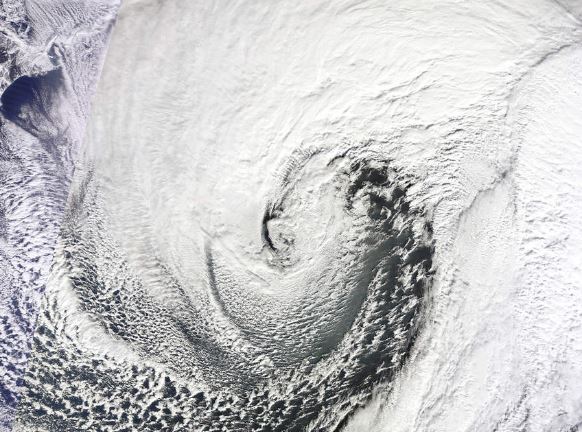What is a weather bomb?
by Ailsa Harvey · 30/01/2020
Learn how intense low-pressure systems drop severe weather on us

When a storm hits, meteorologists may refer to it as a weather bomb, but this isn’t just a dramatic name given to all severe weather events. A weather bomb is in fact the unofficial term used to describe a particular type of low-pressure system that can result in damaging gusts of wind.
Low-pressure systems occur regularly across the planet and are caused by warm air rising from the Earth’s surface. They generally lead to unsettled weather conditions, as when air rises, it cools, causing water vapour to condense and form clouds. However, when an area of low pressure passes beneath a powerful jet stream of rapidly moving air high up in the atmosphere, it develops into something much more intense.
The jet stream removes air from the column of low pressure, reducing its weight so that the pressure at sea level falls even further. If the pressure drops by 24 millibars or more over a 24-hour period this is described as explosive cyclogenesis, which is the official name for a weather bomb.
As the falling pressure sucks in more air, the column begins to rotate faster and faster, resulting in strong winds that peak over a period of a few hours. These winds can be powerful enough to blow down trees and cause structural damage, putting members of the public at risk.
Tiny tremors

Studying tremors that travel through the planet can help scientists better understand Earth’s structure
Storms – including weather bombs – that happen at sea send tiny vibrations known as microseisms through the Earth. This occurs when waves crash together, sending energy into the ocean floor and beyond.
The tremors are more subtle versions of those caused by earthquakes, and fall into two categories: pressure waves, or ‘P’ waves, squeeze and expand the rock, while slower transverse waves, or ‘S’ waves, wobble the rock from side to side. The P waves are routinely picked up by scientists on the opposite side of the world to their source, but S waves are more illusive.
However, in 2014, seismologists in Japan were able to track the source of these slow-moving S waves for the first time, tracing them back to a weather bomb off the coast of Greenland. Researchers hope this breakthrough will open up a new way to study Earth’s interior.
This article was originally published in How It Works issue 99, written by Joanna Stass
For more science and technology articles, pick up the latest copy of How It Works from all good retailers or from our website now. If you have a tablet or smartphone, you can also download the digital version onto your iOS or Android device. To make sure you never miss an issue of How It Works magazine, subscribe today!





